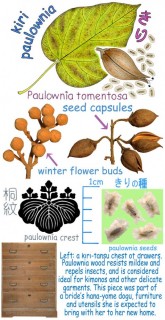Loading
Search
▼ Hanafuda: The essence of Japanese culture in a deck of cards
- Category:World Heritage

THE JAPAN NEWS
One of my Japanese friends has a pack of traditional playing cards called hanafuda. The deck consists of 48 cards, four for each of the 12 months. The term hanafuda means “flower cards,” and each month is represented by a particular flowering plant. There appears to be many ways of playing, but most involve discarding and matching cards, with the goal to collect all of the cards in certain sets.
The plants for each month are assigned based on Japanese traditional feelings for the changing seasons: pines for January, ume plums for February, cherry blossoms for March, and so on. The December plant, a bit surprisingly, is the kiri or paulownia tree. The big blue flowers of this tree, while certainly beautiful, bloom in early summer.
Paulownia is a genus of flowering trees found in Asia and North America. The kiri (P. tomentosa) is native to China, but since ancient times has been widely prized in Japan for its light but strong wood, used to make traditional kiri-tansu chests of drawers, geta sandals and ceremonial musical instruments. Kiri wood is virtually impervious to moisture and rot, repels moths, and doesn’t twist or warp over time. Kiri-tansu are considered ideal for storing kimonos, obi sashes and other delicate Japanese garments.
Paulownia trees also grow very fast. In the past, people used to plant a few behind their house whenever a daughter was born. By the time the girl was ready to marry, the trees would be tall and thick enough to cut down and saw into boards to make a beautiful kiri-tansu for the bride’s hanayome dogu, a set of furniture, garments and utensils she was expected to bring with her to her new home.
At this time of year the paulownia leaves are falling, but the trees can still be easily identified at a great distance by the branches, which are filled with strange-looking objects. A close look shows that there are two types of objects: clusters of fuzzy round balls, about the size of marbles; and larger woody capsules that have already started to split in half lengthwise, like a walnut shell.
The round balls are the winter flower buds. Each one is packed with the makings of a huge, five to six centimeter-long tubular flower that will open in May. The soft, fuzzy covering protects the delicate buds from the winter wind and cold. These flowers don’t last very long, and are easily overlooked, but when properly pollinated they slowly begin to develop into the hard, woody capsules.
The capsules ripen gradually throughout the autumn, and then start to desiccate and crack open in the cold, dry air of late autumn and early winter. Each capsule is packed to the gills with thousands of tiny seeds. The seeds are ribbed, and fitted with a wide, thin membrane that acts as a sail. When a wind rattles the capsules, the seeds are shaken out and go flying for miles and miles across the countryside.
In the saijiki, a collection of seasonal motifs that form the basis for haiku poetry and other Japanese aesthetic expressions of changing seasons, the paulownia flowers are associated with early summer, and the capsules with early autumn. On the other hand, paulownia trees have long been considered a powerful symbol of political authority.
All of Japan’s great 15th and 16th century warlords, including Oda Nobunaga, Toyotomi Hideyoshi, and the founder of the Edo shogunate Tokugawa Ieyasu, were awarded paulownia crests by the reigning Emperor. The crest of the office of prime minister features a gold paulwonia leaf and flower motif on a blue background. The Justice Ministry uses a similar crest, and many of the official medals presented by the government for outstanding achievements feature paulownia motifs. Kiri images were first used on coins in the 16th century, and continue on today’s ¥500 piece.
Paulownia crests, like most Japanese flower motifs, are highly stylized. They typically consist of three leaves, with the veins strongly high-lighted; topped by three sets of flower stalks. Some crests have five flowers in the central stalk and three on either side (gosangiri); while others, like the prime minister’s, have seven in the middle and five on the sides (goshichigiri).
The hanafuda cards that feature only a plant image are of lower value in the game. For each month, however, there is a high-value card that depicts the plant along with an animal traditionally associated with the same season. The most famous of these is the ume ni uguisu, or ‘plum with bush warbler’ card for February. The high-value December card shows the paulownia with a Ho-o, a fantastic bird of Chinese mythology. This bird, translated into English as Phoenix and also called Suzaku in Japanese, is revered as guardian of the south in Asian Feng Shui (Fu Sui in Japanese) metaphysical cosmology. A beautiful image of the Ho-o can be seen at the famous Byodoin temple in Uji, Kyoto Prefecture, and also on the current ¥10,000 bill!
Short is a naturalist and cultural anthropology professor at Tokyo University of Information Sciences.
- December 2, 2014
- Comment (2)
- Trackback(0)
Comment(s) Write comment
where can i buy amoxil - <a href="https://combamoxi.com/">combamoxi.com</a> buy amoxil cheap
-
ut2jp
- July 7, 2025


This is the kind of serenity I take advantage of reading. https://proisotrepl.com/product/colchicine/
Conniereugs Web Site- July 29, 2025